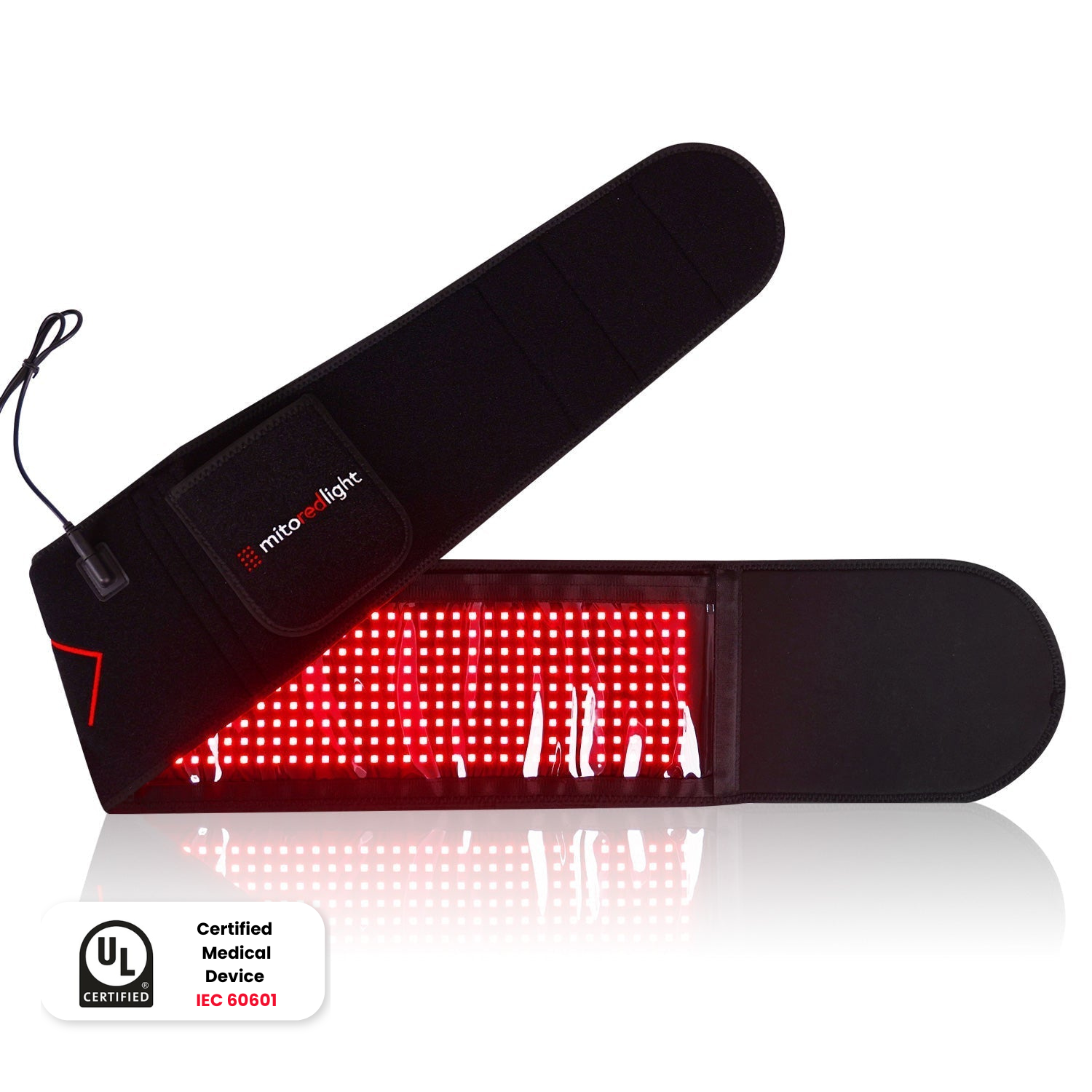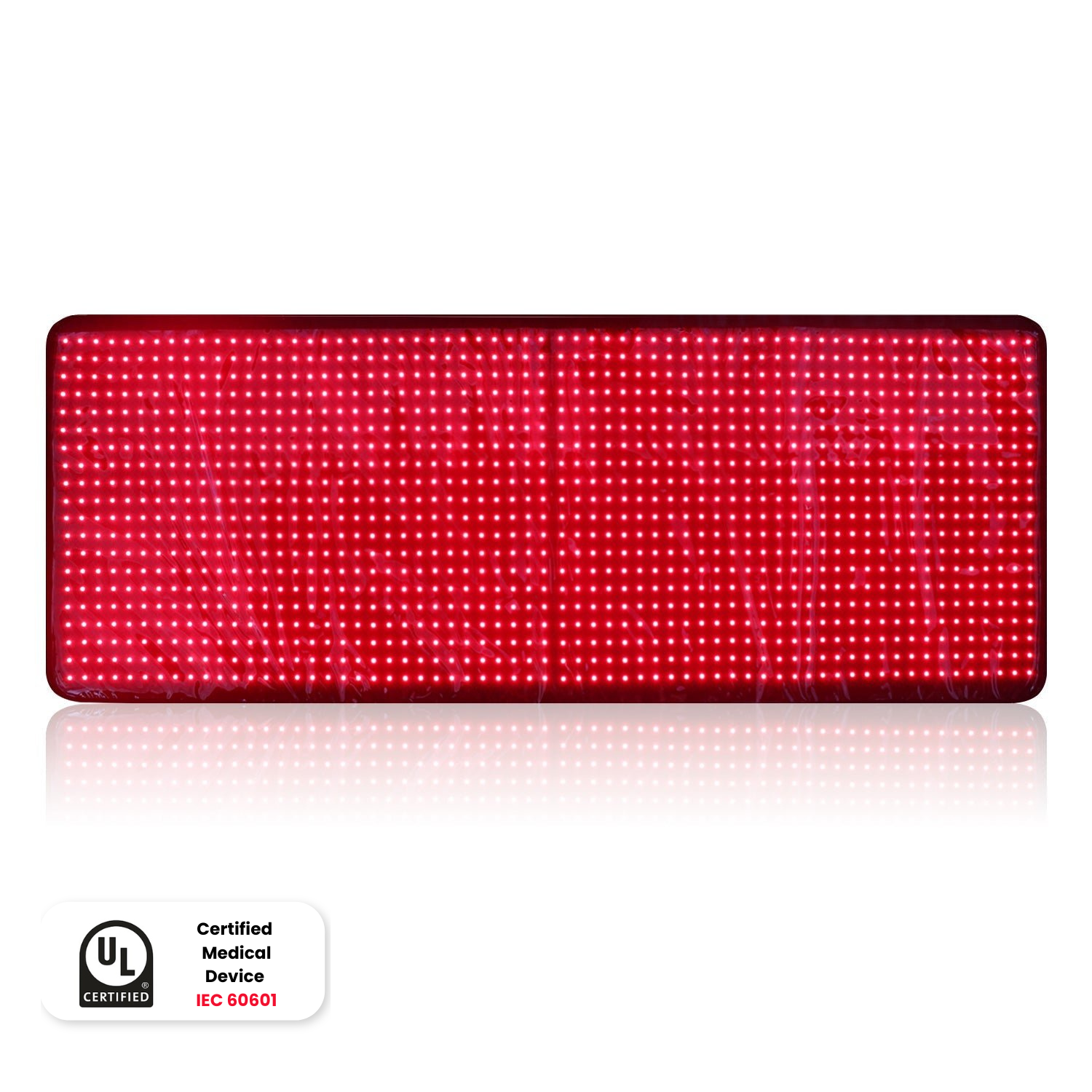DISCLAIMER: Mito Red Light devices are Class II wellness devices aimed at affecting the body through topical heating and supporting cellular function. The information provided in this article and on this site is for educational purposes only and is not intended to imply effectiveness of Mito Red Light devices for any specific application. The information provided in this article and on this site is not intended to diagnose, treat, cure, or prevent any disease, is not a substitute for consultation with a licensed medical provider and should not be construed as medical advice. Click here to read our article on potential contraindications of red light therapy..
Red light therapy is an increasingly popular form of therapy that uses specific wavelengths of red or near-infrared light to achieve health benefits. Red light therapy is administered through the skin and is thought to stimulate mitochondria, the energy-producing organelle found in almost every cell in the body. People use red light therapy for a variety of reasons, including improving sleep quality, reducing skin blemishes and wrinkles, decreasing chronic joint pain, speeding wound healing, and many other reasons.
There are many Important factors to consider when evaluating different providers of red light therapy, but one important component of light therapy is the flicker that the phototherapy unit creates. Understanding what flicker is and how it can affect both your health and the efficacy of your red light therapy is important when considering red light therapy.
What is Flicker?
Flicker is something that most people don’t often think about, but that has numerous potential effects on our health and that is growing in awareness as the use of electric light and especially screen-based lighting technology develops. There are different components to the concept of flicker, but it is essentially quick, repeated changes in the intensity of a light.
Factors Affecting Flicker
Flicker occurs in almost every electronic-based light source to some extent. There are two main parts to flicker that will impact how severe an effect it may have. These include the intensity of the flicker and the frequency of the flicker.
- Intensity - Also called flicker percentage, the intensity of a flicker refers to how big the change in the amount of light is with each flicker. An example of extreme change in intensity would be a strobe light. Strobe lights produce rapid cycles of intense light followed by complete darkness. This on/off type of flicker has a flicker percentage of 100%.
- Frequency - Flicker may, but does not always, occur at a specific frequency. If flicker is rhythmic, the frequency refers to how many times each second the flicker occurs. Frequency is often measured in hertz (Hz), which is simply the number of flickers in a second. Low frequency flicker may be visible, but high frequency flicker may still affect you without being visible.
The effect that flicker has will almost always be influenced by the combination of these two factors.
Visible vs Invisible Flicker
Flicker may be visibly noticed, but may also be invisible. Invisible flicker may still have negative health effects, and it is important to understand that simply being unable to see flicker does not mean that it will not affect you.
Both intensity and frequency play a role in how visible flicker is, however, frequency plays a much larger role. The role of intensity is quite straightforward. If you consider an intense strobe light, the effects of flicker will certainly be noticeable. If instead of turning off, the light was to dim, then go back to full power, there would be a certain level of change where the change would be so small that you would not perceive the differences between the dim intensity and the full intensity. As the intensity becomes less perceptible, the effect of flicker also decreases.
Frequency plays a much larger role in the visibility of flicker than intensity does. Frequency refers to how many times per second a light source dims or turns off. There are multiple effects that frequency can have on flicker.
- Visible flicker - Flicker up to 50 Hz (or cycles per second) will be visible to most humans. This flicker may create negative health effects and seem unpleasant or irritating, however, people will typically perceive that the light source appears to be rapidly flashing.
- Flicker Fusion Threshold - The flicker fusion threshold is slightly different for each individual and refers to the rate of flicker in which rapid flashing is perceived by the brain as a single, steady light source. The brain interprets this rapid flicker as a steady light in the same way that it interprets the multiple, sequential images that make up a video as motion. The flicker fusion threshold will normally fall in the range of 50-90 Hz.
- Invisible Flicker - Any flicker that is greater than 90Hz will generally not be noticeable. However, a flicker frequency that is still less than 100Hz may cause negative health effects.
What Causes Flicker?
There are many potential causes for flicker, but one of the main causes is related to the type of current that is used for most electric lights. There are two types of electrical currents: direct current (DC) and alternating current (AC). There are certain advantages to AC power that have made it the predominant form of power that is transmitted and used throughout the world. The lights in your home and the power that comes out of the outlets in your wall all use AC power.
While DC power provides a steady stream of electrical current that moves in one direction, AC power uses electricity that alternates direction many times per second. AC power can be thought of as an electrical current that moves back and forth very rapidly or as moving like a wave. An analogy of these two forms of power could be a drill vs. a jackhammer. The drill’s action involves moving steadily in one direction, while a jackhammer moves up and down. While both operate differently, they both effectively transfer energy.
Because of the unique properties of AC power, AC results in many surges and drops in power within a single second. This has different effects based on the type of light being used. A normal incandescent light bulb, for example, creates light by using electricity to heat the filament. The rapid changes in electrical current do not create enough time for the filament to cool down between AC cycles, making flicker very negligible. Fluorescent lights, however, do dim between cycles, making a flicker that is noticeable if the frequency of the power falls to a low enough level.
Red light therapy uses LED lights because this form of lighting reliably provides the wavelengths of light needed for the therapy to be effective. LED lights are more prone to flicker caused by AC power than incandescent light bulbs, but are normally less prone to flicker than fluorescent lights.
The other main cause of flicker is not related to red light therapy and includes screen refreshes. Screens found in computers, smart phones, and TV displays refresh multiple times each second. Modern equipment is engineered for this source of flicker to have a negligible effect, but older, aging, or malfunctioning equipment can provide a significant source of flicker.
Undesirable Effects of Flicker
There are several potentially undesirable effects of flicker. While scientists do not fully understand all of these effects, they do know that these effects can, and do, occur due to flicker.
Seizures
Seizures are perhaps the most severe side effect of flicker. Flickering lights are known to cause seizures in a small percentage of the population and can lead to epileptic emergencies. In one of the most famous cases of this, a 1997 episode of the popular Japanese television show Pokémon used a series of flashing lights that triggered seizures throughout the country, requiring almost 700 children to seek hospitalization.
While seizures are a rare effect of exposure to flicker, flicker can have a dangerous effect on those who are susceptible to seizures or have an existing seizure disorder.
Other Short-Term Effects
There are several other short-term effects that flicker can cause. The subconscious strain that flicker creates on the neurological system can lead to:
- Headaches
- Migraines
- Difficulty concentrating
- Vertigo
- Dizziness
- Panic attacks
The actual effects experienced by a particular individual will vary based on their unique health and based on how severe the exposure to flicker is. The effects of flicker have been shown to impact women and older individuals more than the rest of the population.
Long-Term Effects
Exposure to most forms of flicker does not typically create significant long-term effects, but can where there is a high amount of continued exposure. An example of this would be someone who works in an office space with an aging fluorescent bulb that is creating visible flicker. Failing to change the bulb for several weeks could result in long-term effects. The long-term effects of flicker can include:
- Chronic migraines
- Chronic fatigue
- Anxiety
- Depression
- Irritability
Long-term effects of flicker may be hard to recognize, and people who experience these effects may not understand why they are being caused, especially if the flicker causing them is not visible.
Does Flicker Affect Red Light Therapy?
Red light therapy depends on the specific wavelength of light that is administered through the skin. There are no studies showing that flicker affects how effective red light therapy is and no significant reports of flicker affecting therapy. The main reason that red light therapy is unlikely to be affected by flicker is that flicker does not affect the way that it actually works.
Red light therapy primarily depends on the wavelength that penetrates the skin and reaches mitochondria. Flicker may affect the intensity of the light in a small way, but small changes in the intensity, regardless of the frequency of these changes, are not something that affects the actual wavelength being administered.
Red Light Therapy Without Flicker
It is impossible to completely eliminate every kind of flicker from any light source, however, there are methods of reducing potential flicker to such a negligible level that any flicker that does occur has no potentially harmful effects.
While there is no evidence that the effectiveness of red light therapy is affected by flicker, there is at least some possibility that exposure to flicker could lead to undesirable effects. For this reason and because we believe in listening to our customers, Mito Red has integrated proprietary technology into each of our red light therapy units, designed to make sure that our units do not create potentially harmful flicker. By investing in this additional safety step, Mito Red Light enables our device’s users to confidently get the benefits of red light therapy without the potential risks of flicker.
Below are the testing results of our 3 series of lights, all registering well below 1%.
Mito Red Original Series - 0.73%

MitoMOD Series - 0.90%

MitoPRO Series - 0.87%

Mito Red Light provides a variety of red light therapy products that are designed to provide the specific wavelengths of light that are thought to help stimulate mitochondria and bring about the various positive benefits of red light therapy. We welcome you to review our selection of high-quality products or to contact one of our friendly representatives at +1 866-861-6486.
Related Articles:






























